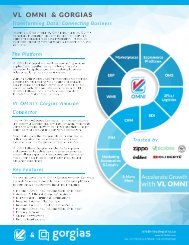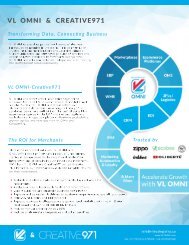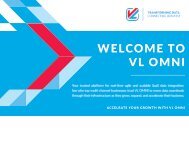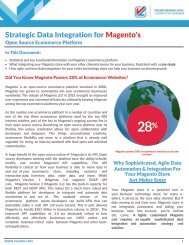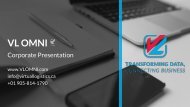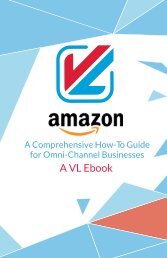[Ebook] EDI: A Thought Leadership Ebook for SMBs
EDI is an interesting animal. The granddaddy of cloud data integration, EDI has been pronounced 'dead' so many times over the last decade (or more) that businesses new to the EDI space sometimes feel like they're stepping into a time machine. For businesses who already do EDI, your existing EDI solution might actually be a relic. In both circumstances, businesses are left to navigate a complex and confusing EDI world. So, in order to help businesses new to or revamping their existing EDI solutions, VL has revamped our popular EDI ebook. Keep reading to download your copy, and to learn more about what you'll find beyond the cover!
EDI is an interesting animal. The granddaddy of cloud data integration, EDI has been pronounced 'dead' so many times over the last decade (or more) that businesses new to the EDI space sometimes feel like they're stepping into a time machine. For businesses who already do EDI, your existing EDI solution might actually be a relic. In both circumstances, businesses are left to navigate a complex and confusing EDI world. So, in order to help businesses new to or revamping their existing EDI solutions, VL has revamped our popular EDI ebook. Keep reading to download your copy, and to learn more about what you'll find beyond the cover!
You also want an ePaper? Increase the reach of your titles
YUMPU automatically turns print PDFs into web optimized ePapers that Google loves.
A <strong>Thought</strong> <strong>Leadership</strong> Guide to<br />
<strong>EDI</strong><br />
A VL OMNI <strong>Ebook</strong><br />
www.VLOMNI.com 1
Contents<br />
Introduction<br />
Chapter 1<br />
<strong>EDI</strong>: What You Should Know<br />
Chapter 2<br />
Be<strong>for</strong>e Your <strong>EDI</strong> System: How Clean is Your Data<br />
05<br />
06<br />
07<br />
Chapter 3<br />
What You Should Know About <strong>EDI</strong> Compliance<br />
Testing 08<br />
Chapter 4<br />
Predictions & Groupthink: How to not get Trapped<br />
10<br />
Chapter 5<br />
Buyer beware: Two Common Pitfalls Surrrouding<br />
12<br />
Chapter 6<br />
<strong>EDI</strong> System Selection: Plan <strong>for</strong> Growth & Your<br />
Needs<br />
14<br />
www.VLOMNI.com 3
Chapter 7<br />
Why Your <strong>EDI</strong> System should do more than just<br />
<strong>EDI</strong><br />
Chapter 8<br />
AS2 & The Death of the <strong>EDI</strong> Value Added Network<br />
16<br />
17<br />
Chapter 9<br />
The Shortcomings of Partially Integrated <strong>EDI</strong><br />
Chapter 10<br />
10 Steps <strong>for</strong> Approaching a New <strong>EDI</strong> System<br />
18<br />
19<br />
Chapter 11<br />
<strong>EDI</strong> Integration: 5 Common Mistakes 21<br />
Chapter 12<br />
The Rise of Spreadsheet and Flat File<br />
Integration 23<br />
Conclusion 24<br />
Resources<br />
25<br />
About VL 26<br />
4<br />
www.VLOMNI.com
Introduction<br />
This thought leadership guide covers a wide range of topics surrounding <strong>EDI</strong> and <strong>EDI</strong>-related solutions <strong>for</strong><br />
<strong>SMBs</strong> . We start this ebook with reviewing the role <strong>EDI</strong> has played in buisness in the past, moving into how<br />
<strong>EDI</strong> is used and integrated into business operations today, following with predictions <strong>for</strong> the future. Along<br />
the way, we will address the many pitfalls any business may encounter, including partner recommeded solutions,<br />
hype cycles, groupthink, and common assumptions. Our goal in writing this ebook is provide an educational<br />
source of in<strong>for</strong>mation regarding <strong>EDI</strong> to help you, the reader, make in<strong>for</strong>med decisions as you look to<br />
adopt <strong>EDI</strong> <strong>for</strong> the first time, update xisiting systems, or find efficiencies and cost vings.<br />
We at VL hope you enjoy reading the expert knowledge complied this ebook <strong>for</strong> more resources and in<strong>for</strong>mation<br />
on how VL can help your buisness with <strong>EDI</strong>,or any other omni-channel data integration needs, visit<br />
VLOMNI.com.<br />
- The VL Team<br />
www.VLOMNI.com 5
Chapter 1<br />
<strong>EDI</strong>: What You Should Know<br />
When computers started to be used by major organizations back in the 1960’s, there was a immediate need<br />
<strong>for</strong> systems that could communicate and exchange business in<strong>for</strong>mation between applications in a consistent<br />
manner.<br />
While the data exchange processes were proprietary at first, ANSI (American National Standards Institute)<br />
and UN/<strong>EDI</strong>FACT (United Nations Directories <strong>for</strong> Electronic Data Interchange <strong>for</strong> Administration, Commerce,<br />
and Transport) developed Electronic Data Exchange (<strong>EDI</strong>) standards. These standards to set international<br />
guidelines <strong>for</strong> data communication and movement, and provided a consistent method <strong>for</strong> how different<br />
computer systems were to move data from one to another. Each type of <strong>EDI</strong> document was assigned a<br />
number. For example, X12 documents have these numbers referenced against the <strong>EDI</strong> standards by computers<br />
in order to decode what type of document was being sent. <strong>EDI</strong>, put simply, standardized the electronic<br />
sending and receiving of documents, no matter the industry.<br />
And <strong>EDI</strong> has been a central method <strong>for</strong> moving business documents electronically ever since -- although<br />
developments in automation and technology have allowed <strong>for</strong> imprevements in sophistication. For example<br />
integrated <strong>EDI</strong> is of utmost importance today if a business has a certain level high of volume with customers<br />
or vendors; without integrated <strong>EDI</strong>, fulfilling these t ansactions is near impossible.<br />
Over time, <strong>EDI</strong> has evolved from its original <strong>for</strong>mat and use, and is still highly used today. <strong>EDI</strong> is crucial to the<br />
functionality of many businesses, and will likely continue to be <strong>for</strong> the <strong>for</strong>eseeable future as <strong>EDI</strong> remains a<br />
core communication method <strong>for</strong> many retailers and supply chain partners.<br />
Some Common <strong>EDI</strong> Transactions<br />
<strong>EDI</strong> and the transactions it handles can be complex, but management should be aware of some basic fuctions.<br />
Purchase Orders (POs) (<strong>EDI</strong> document number 850 or 875) <strong>for</strong> goods or services are built using<br />
<strong>EDI</strong> standards. This includes the <strong>for</strong>mat and size of the purchase order number, the date, the billing in<strong>for</strong>mation,<br />
and the shipping in<strong>for</strong>mation. Purchase Order <strong>EDI</strong> documents also include in<strong>for</strong>mation regarding,<br />
and the line item in<strong>for</strong>mation including quantity, product number, product description, and price. Basically<br />
Everything that was on a paper PO is included in an <strong>EDI</strong> PO.<br />
Invoices (<strong>EDI</strong> document number 810 or 880) follow purchase orders. The <strong>EDI</strong> 810 document replaced the<br />
paper invoice. Many businesses created agreements surrounding these <strong>EDI</strong> standards and pay according to<br />
the results of the electronic transactions.<br />
Shipping Notices (<strong>EDI</strong> document number 856) are sent in response to an <strong>EDI</strong> purchase order after it’s received.<br />
The shipping notice or ASN (Advance Ship Notice) is sent be<strong>for</strong>e a shipment arrives at the customer,<br />
and in some cases it becomes the physical invoice.<br />
6<br />
www.VLOMNI.com
This allows the customer’s computer to validate what was shipped against the purchase order, so when<br />
the actual goods are checked in at the receiving warehouse or store, an automated confirmation of receipt<br />
occurs. The electronic reconciliation enables a retailer to greatly reduce costs associated with the manual<br />
handling of shipments.<br />
There can be additional <strong>EDI</strong> transactions in a more complex supply chain where third party warehousing<br />
and fulfillment (3PL) is used. Warehouse Ship Documents (<strong>EDI</strong> number 940) are used with warehousing<br />
and distribution to send a shipping request to a third party logistics partner or fulfillment house. Shipping<br />
Advices (<strong>EDI</strong> number 945) are then returned by the third party logistics provider to notify and confirm that<br />
the items that have shipped and invoicing is required.<br />
There is much more beyond these basic <strong>EDI</strong> transaction numbers to know, but more depth of knowledge at<br />
this point is usually left to technical experts. Management, at the very least, should be aware of these six <strong>EDI</strong><br />
document types reviewed in this chapter.<br />
www.VLOMNI.com 7


![[Ebook] EDI: A Thought Leadership Ebook for SMBs](https://img.yumpu.com/59180988/1/500x640/ebook-edi-a-thought-leadership-ebook-for-smbs.jpg)





